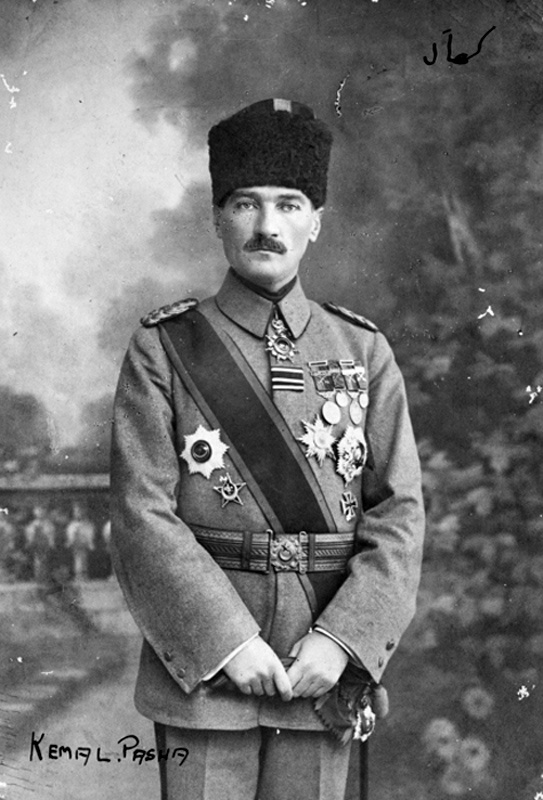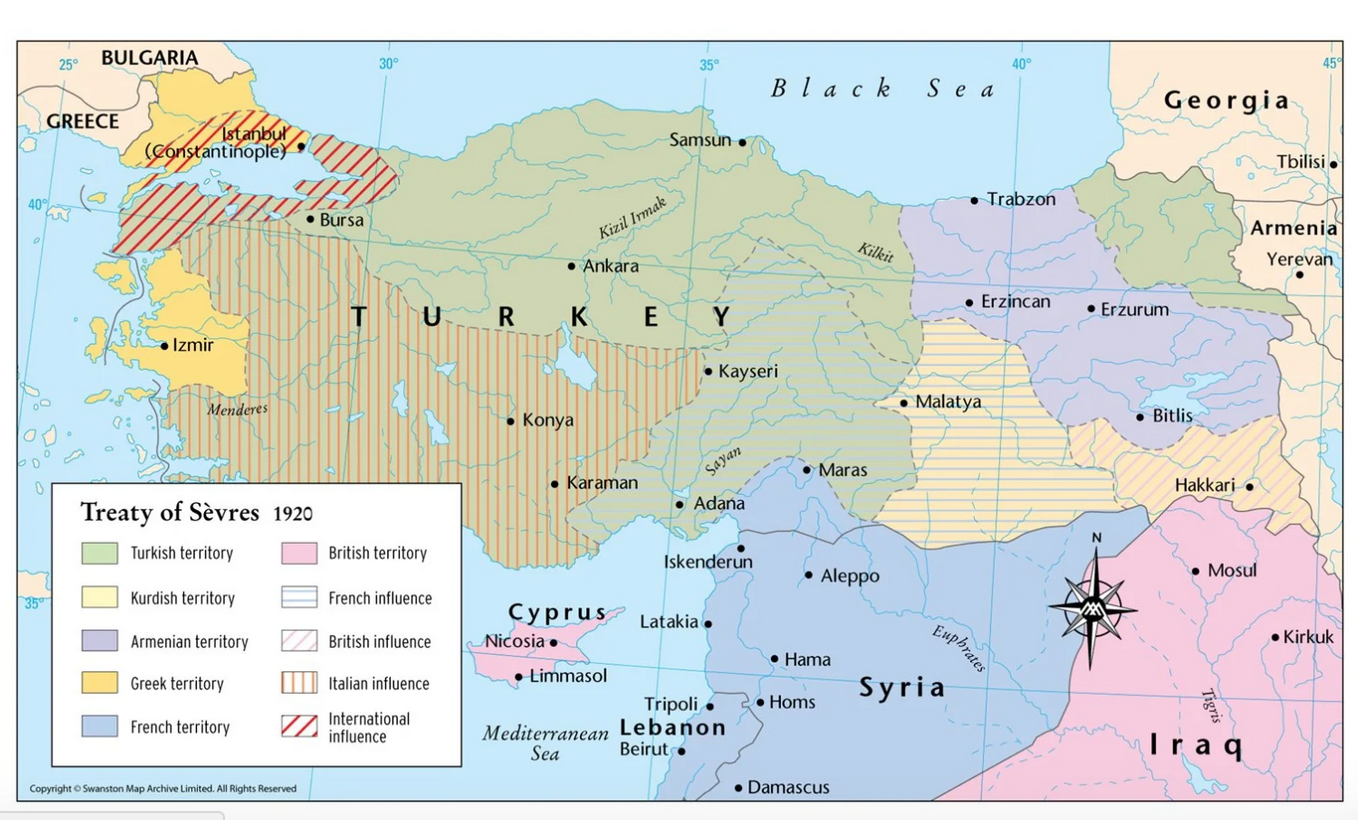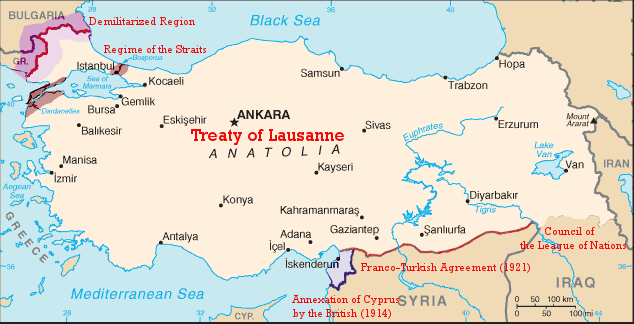8. The impact of the First World War up to 1923
 The Ottomans had lost the war; although this was a catastrophe it was actually the events after the war which led to the final demise of the Empire. As Eugene Rogan writes, 'Caught between the conflicting demands of the victorious powers and Turkish nationalists, the Ottomans ultimately fell more as a result of the terms of the peace than of the magnitude of their defeat'.
The Ottomans had lost the war; although this was a catastrophe it was actually the events after the war which led to the final demise of the Empire. As Eugene Rogan writes, 'Caught between the conflicting demands of the victorious powers and Turkish nationalists, the Ottomans ultimately fell more as a result of the terms of the peace than of the magnitude of their defeat'.
'At war's end most Ottoman territory had been pledged to one or another of the Allied partners. Because some of the pledges contradicted one another, they could be implemented only by compromise or the exercise of armed force.'
Cleveland and Bunton, pg 152
Starter:
Watch the following video as an overview to this final section.
- What problems did the Ottoman Empire face at the end of the war?
- What aims does Mustafa Kemal have in 1919?
- What does Kemal claim about the Sultan's government?
- Where does an alternative government proclaim itself? What is its aim?
- Why is the Treaty of Sevres a catastrophe for Turkey?
- What was the role of Britain and France in the Ottoman Empire following the war?
- What factors lead to the Treaty of Lausanne? What is the significance of this Treaty?
Following the collapse of the other Central Powers, the Ottomans signed the armistice of Mudros with the Allies on 30 October 1918. The Young Turk government led by Enver Pasha had collapsed in the days leading up to the armistice. Enver, Cemal Pasha and Talât Pasha had all fled the country to seek sanctuary in Germany.
Across what was left of the empire law and order broke down completely in many places and ethnic and religious tensions erupted into violence. The country had suffered enormously during four years of war; the population of Anatolia had declined by at least 20 per cent. The war had disrupted much of the country's infrastructure and famine was widespread. The Allies marched into Constantinople with the intention of taking control of large areas of Anatolia. Their pretext was the restoration of order, but this plan also reflected the terms of the peace settlement they were drafting.This peace treaty was not signed however until April 1920 due to arguments amongst the Allies. The Treaty of Sevres was finally signed following the conference of San Remo which brought together the European Powers that had a territorial interest in the redistribution of he Ottoman territory to the negotiating table. The conference resolved the British and French differences and accepted the terms of the Balfour Declaration

Read the terms of the Treaty of Sèvres below; also look at the map above of the Ottoman Empire in 1914 and the map below showing the changes brought about by the Treaty.
- In pairs discuss what factors seems to have determined the terms of this Treaty.
- One of the key principles followed by the peace makers at the end of the First World War was the principle of self-determination; this was one of President Wilson's 14 points. How far is this principle followed in the Treaty of Sèvres?
- If you have studied the Versailles Settlement for another topic, discuss how this Treaty is both similar and also different to the Treaty signed with Germany and the other Central Powers
- What was the Turkish response likely to be to this Treaty?

https://nathangoldwag.wordpress.com/2020/11/29/the-treaty-of-sevres-the-middle-east-that-wasnt/
The term of the Treaty were as follows:
- Syria went to France as a mandate
- Palestine, Iraq, Transjordan and Cyprus went to Great Britain as mandates

- Eastern Thrace and Izmir in the western Anatolia went to Greece
- Rhodes and the Dodecanese Islands went to Italy
- Smyrna was occupied by the Greeks for five years and then a plebiscite was due to be held
- The Straits (exit from the Black Sea) were to become a demilitarized zone administered by the League of Nations, and Britain, France and Italy were to keep troops in Turkey.
- a democratic Republic of Armenia was created
- The Allies were to control the Empire's finances. this included the supervision of the Empire's national budget, and total control of the Ottoman Bank
- The Ottoman army was to be reduced to 50 000
- an independent Kurdish zone was proposed
- Sharif Hussein ibn Ali was rewarded for his leadership of the Arab Revolt with international recognition of the Hejaz as an independent kingdom.
Watch video from 32 minutes until 42 minutes where Albert Schram discusses the Treaty of Sèvres
- What points does Schram make about the factors that determined the Treaty of Sèvres ?
- What does he say makes this Treaty different from the other treaties of the Treaty of Versailles?
Some students may wish to watch the whole of this lecture which has good analysis regarding the whole period and focuses on the differences of the Ottoman Empire to other countries during the war.
The timings are:
[03:35] 5 Differences: outbreak, nature, effects on population, the end and the political legacy
[06:37] Spirit of 1914 or war enthusiasm.
Ottoman Empire was different regarding:
[08:00] 1- Outbreak of war
16:20] 2- Nature of warfare
[25:14 ] 3- Effects on population
[31:54] 4- WW1's end
[41:58] 5- Political legacy
[54:53] Q&A
As discussed in the video above the Treaty of Sèvres was different to the other treaties of the Versailles settlement; the victors were determined to pursue their own national interests and so the interests of the Turks were not considered. By accepting the Treaty, and thus seeming to be a puppet of the Allies, the Sultan was to secure his downfall.
Read the sources below.
What problems are identified regarding the Treaty of Sèvres?
Source A
In drawing up the settlement, the Allied negotiators were compelled ot take into consideration the new principle of national self-determination - yet they chose to apply the principle only when it furthered their own interests or coincided with their sympathies. It was doubtless for the latter reason that the Treaty of Sèvres recognized an independent Armenian state in eastern Anatolia and Russian Caucasia. The Allies also agreed that the Kurdish regions of eastern Anatolia should have semiautonomous status. In approving self-determination for the Armenians and partial self-determination for the Kurds, however. the Allies made it clear that they would not provide military or financial assistance ot these two fledgling nations. They did not, therefore. endure for long'
Cleveland and Bunton, pg 153
Source B
The Treaty of Sèvres carried with it the seeds of future troubles in the region. This was because it was written in total disregard of the sentiments of the Turkish people. The victor nations were so keen to pursue their own national interests that they behaved as though the Turks no longer existed and that their goods could be auctioned ot the highest bidder. Though it maintained the Ottoman Sultan in office, by reducing his army and taking away his control on major ports as well as the country's finances, the treaty made him weak, dependent on the West and vulnerable to internal challenge.
Mariam Habbibi, History of Europe and the Middle East, OUP, pg 187
The treaty was accepted by Sultan Muhammad VI. Yet there was fierce resentment to the terms and following the Turkish War of Independence (see below) the Turks were able to force the annulment of the Treaty of Sèvres and obtain the Treaty of Lausanne in June 1923. This gave the Republic of Turkey recognition as an independent nation-state free of interference from foreign powers.

The Terms of the Treaty of Lausanne were as follows:
- Turkey regained Eastern Thrace, Smyrna, some territory along the Syrian border and several Aegean islands
- Turkish sovereignty over the Straits was recognized, but the area remained demilitarized
- Foreign troops were withdrawn from Turkish territory
- Turkey no longer had to pay reparations or have its army reduced.
- Turkey was given back control over its financial and judicial matters
Compare the terms and the maps of the two Treaties above.
- In pairs discuss the differences between these two Treaties - what were the most significant differences for Turkey between the two Treaties?
- Overall what had Turkey lost as a result of the war in terms of territory?
What factors led to the rise of Ataturk?
 The reason for Turkish success in changing the Treaty of Sevres lay in the actions of the Mustapha Kemal - also known as Atatürk, a Turkish nationalist who believed that the once-great Ottoman Empire had become a dead weight on the Turkish people, who now needed a homeland of their own.
The reason for Turkish success in changing the Treaty of Sevres lay in the actions of the Mustapha Kemal - also known as Atatürk, a Turkish nationalist who believed that the once-great Ottoman Empire had become a dead weight on the Turkish people, who now needed a homeland of their own.
Atatürk had already played a key part in the war, earning a reputation for his actions during the Gallipoli campaign. By 1919, his main objective was to rid Turkey of the presence of foreign troops, reverse the Treaty of Sèvres and restore Turkish sovereignty in Anatolia.
The greatest military threat to the Turkish nationalists came from the Greeks, whose claims to western Anatolia, eastern Thrace and Constantinople were reinforced by the large ethnic Greek populations in those areas. On 15 May 1919 Greek troops occupied the ancient port city of Smyrna. There were serious clashes with Turkish civilians which greatly increased nationalist sentiment. The Greek presence was a major blow to Turkish pride as for centuries Greece had been an Ottoman colony. When the Greeks advanced further into Anatolia, this triggered off an upsurge in Turkish nationalism and started the Turkish war of Independence.
The Sultan was under pressure by the Allies to put down this nationalist movement. However, on 23 April 1920 the nationalists convened a Grand National Assembly in Ankara, deep in central Anatolia. They elected Mustafa Kemal as its first president, effectively establishing an alternative government. The Ottoman government responded by sentencing Mustafa Kemal to death in absentia. However when the Treaty of Sèvres was published, the Sultan's government lost all credibility. Turks of all political persuasions began to unite behind the Grand National Assembly, which completely rejected the treaty.
With the help of money and weapons from Soviet Russia, Atatürk's troops crushed the Armenians in the east and forced the French and Italians to withdraw from the south. He also managed to defeat the Greeks; the war lasted two years and ended in September 1922 when the Turks liberated Izmir and drove the Greeks out of Turkey
 Following Atatürk's victories the Armistice of Mudanya was signed between Turkey, Greece and Britain and the new Treaty of Lausanne was agreed (see above)
Following Atatürk's victories the Armistice of Mudanya was signed between Turkey, Greece and Britain and the new Treaty of Lausanne was agreed (see above)
Meanwhile, 1 November 1922, the Grand National Assembly passed a law abolishing the sultanate and on 29 October, following the signing of the Treaty of Lausanne, Turkey was proclaimed a Republic with Atatürk as its first President.
Turkey now had a new secular government with a focus on creating a new Turkish national identity.
Watch the first 25 minutes of this video which gives more detail on the Turkish War of Independence and the conflict with the Greeks.
- What issues made creating a Peace Treaty with the Ottoman Empire difficult?
- What factors led the Greeks to invade Turkey?
- What impact did the Greek invasion have on the actions of Mustafa Kamal?
- What were the characteristics of the war which followed?
1. Create a timeline from 1914 to 1923 to show the key events of the First World War and after which impacted on the Ottoman Empire.
1. Review the territorial and economic impact on the Ottoman Empire as a result of the war (see above the Treaty of Lausanne)
2. Review the political impact of the war on the Empire (see above, the actions of Atatürk and change of government and ideology underpinning the government)
3. Read the section below on the impact of the war on Anatolia - the new Turkey after the Treaty of Lausanne - for more details on the economic, cultural and physical impact of the war.
Create an infographic, such as the one below, to show the effects of the First World War on the Ottoman Empire

'It is hard to envisage the condition of the country that had won its continued survival and its independence in Lausanne. After ten years of almost continuous warfare it was depopulated, impoverished and in ruins to a degree almost unparalleled in modern history. Demographically it showed the effects of large-scale migration and mortality'
Erich J. Zurcher, Turkey, A Modern History, I.B. Tauris, 2004
Casualties
In particular the Anatolian population suffered a great number of deaths. The Ottoman Empire had always recruited most of its soldiers among the peasant population of Asia Minor and so there were thousands of casualties in the campaigns in the Caucasus, Gallipoli, Palestine and Mesopotamia. Fighting had also taken place in Anatolia itself form 1915. It had also led to the deportation and partial extermination of the Armenian community.
The Turkish War of Independence caused more casualties. Large-scale atrocities had been committed on both sides - the Greeks against the Muslim population and the Turks against the Greek Orthodox population.
In addition, famine and epidemics had taken place - caused by the disruption of the infrastructure and of agriculture
In total the population of Anatolia declined by 20 per cent - a percentage which was 20 times higher than France which had suffered most during the war.
Migration
During and after the war several hundred thousand Armenians emigrated from Anatolia mainly to the Soviet Union, France and the USA. They were followed by large numbers of Greeks from western Anatolia
Under the provisions of the Treaty of Lausanne, the remainder of the Greek Orthodox population of Anatolia, about 900, 000 people, was exchanged against the Muslims of Greece - 400 000 (though a large majority of the Greek population had already fled in 1922)
These migrations mean that another 10 per cent of the population was lost to Anatolia; this also meant the loss of skilled people which made the rebuilding of the country much harder
Cultural change
The population changes also led to large cultural shifts. The larger Christian communities were practically gone; Anatolia was 80 per cent Muslim before the war but was approximately 98 per cent Muslim after the war
Physical damage
The main structural damage was to the infrastructure and housing - due to fighting and deliberate destruction by the withdrawing Greek army.

 IB Docs (2) Team
IB Docs (2) Team
